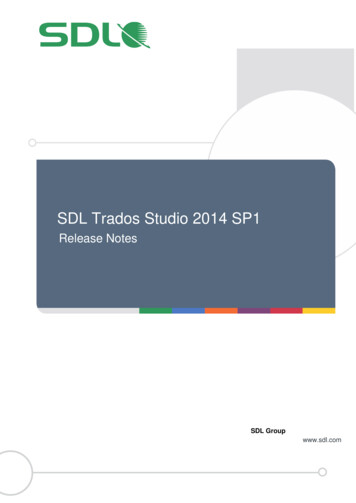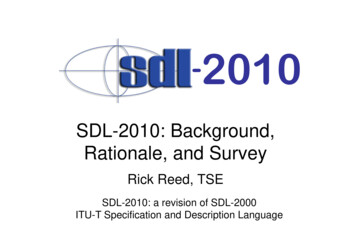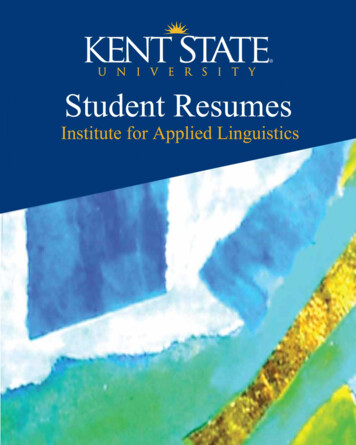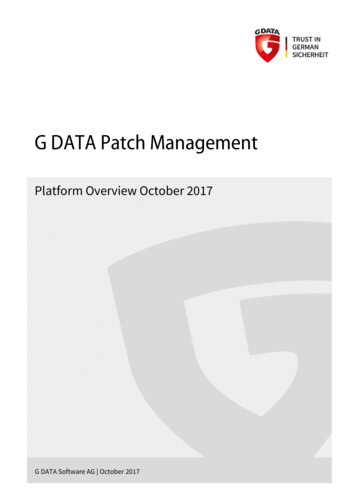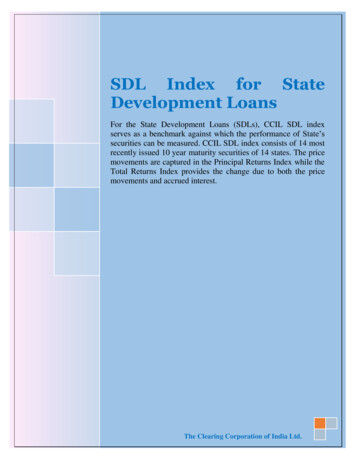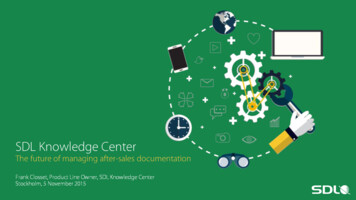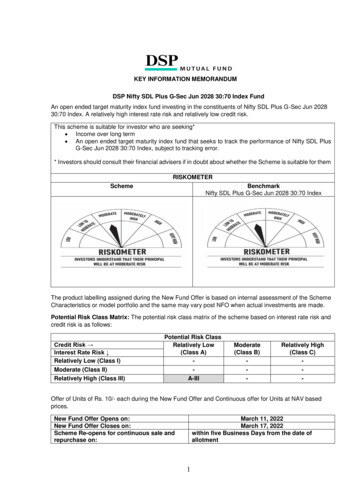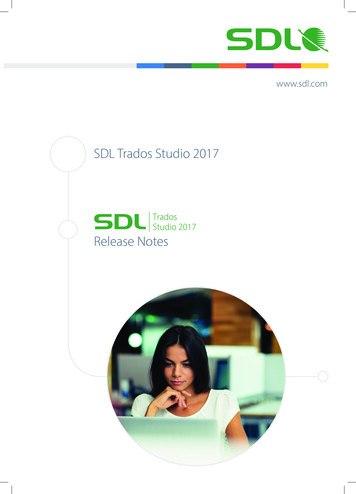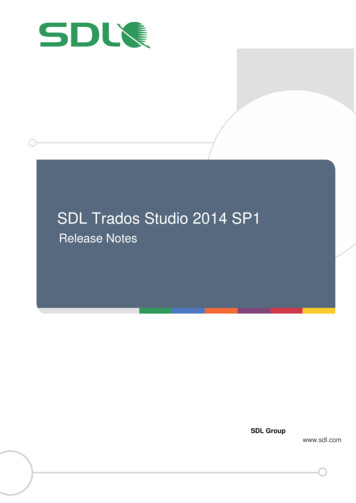
Transcription
SDL Trados Studio 2014 SP1Release NotesSDL Groupwww.sdl.comSDLTridion
Table of contents1. SDL Trados Studio Overview . 42. What’s New in Studio 2014 SP1? . 53. Licensing . 8Licensing Studio 2014 from Studio 2011 . 8Licensing 2014 SP1 from Studio 2014 . 84. Installation . 9Prerequisites . 9Installing and upgrading to Studio 2014 SP1. 105. Compatibility . 11Previous Studio versions. 11SDL server software . 12MultiTerm Desktop . 12SDL enterprise software. 126. Supported Releases . 137. Localization. 148. Resolved Issues . 159. Known Issues . 1710. Further Information . 18Contacting technical support . 18Enhancement requests . 18Help . 18SDL Trados Studio 2014 SP1 – Release Notes2
Copyright InformationSDL Trados Studio 2014 SP1 - Release NotesCopyright 2000-2014 SDL Group.Nothing contained herein may be reproduced, copied, modified or adapted, without the prior written consent of SDLGroup.SDL Group means SDL PLC. and its subsidiaries. All intellectual property rights contained herein are the sole andexclusive rights of SDL Group. All references to SDL or SDL Group shall mean SDL PLC. and/or its subsidiariesdetails of which can be obtained upon written request.All rights reserved. Unless explicitly stated otherwise, all intellectual property rights including those in copyright in thecontent of this documentation are owned by or controlled for these purposes by SDL Group. Except as otherwiseexpressly permitted hereunder or in accordance with copyright legislation, the content of this site, and/or thedocumentation may not be copied, reproduced, republished, downloaded, posted, broadcast or transmitted in anyway without the express written permission of SDL.SDL Trados Studio, SDL MultiTerm Desktop, SDL MultiTerm Online, SDL Studio Groupshare, PerfectMatch, SDLX,SDL Passolo, TranslationZone, SDL Translator's Workbench, SDL TagEditor, QuickPlace, AutoSuggest, SDLBeGlobal and GlobalConnect are registered trademarks of SDL Group. All other trademarks are the property of theirrespective owners. The names of other companies and products mentioned herein may be the trademarks of theirrespective owners. Unless stated to the contrary, no association with any other company or product is intended orshould be inferred.This product may include open source or similar third-party software, details of which can be found by clicking theAcknowledgments section.Although SDL Group takes all reasonable measures to provide accurate and comprehensive information about theproduct, this information is provided as-is and all warranties, conditions or other terms concerning the documentationwhether express or implied by statute, common law or otherwise (including those relating to satisfactory quality andfitness for purposes) are excluded to the extent permitted by law.To the maximum extent permitted by law, SDL Group shall not be liable in contract, tort (including negligence orbreach of statutory duty) or otherwise for any loss, injury, claim liability or damage of any kind or arising out of, or inconnection with, the use or performance of the Software Documentation even if such losses and/or damages wereforeseen, foreseeable or known, for: (a) loss of, damage to or corruption of data, (b) economic loss, (c) loss of actualor anticipated profits, (d) loss of business revenue, (e) loss of anticipated savings, (f) loss of business, (g) loss ofopportunity, (h) loss of goodwill, or (i) any indirect, special, incidental or consequential loss or damage howsoevercaused.Information in this documentation, including any URL and other Internet Web site references, is subject to changewithout notice. Without limiting the rights under copyright, no part of this may be reproduced, stored in or introducedinto a retrieval system, or transmitted in any form or by any means (electronic, mechanical, photocopying, recording,or otherwise), or for any purpose, without the express written permission of SDL Group.AcknowledgmentsSDL Trados Studio includes open source or similar third-party software: Hunspell distributed under GNU Lesser General Public License version 3 Sharpziplib and Spring.net distributed under GNU General Public License version 3 with restrictions ICU distributed under IBM ICU License Log4Net, Xalan and Xerces distributed under Apache License version 2.0 Wix distributed under Common Public License version 1.0 SQLite which is public domain and requires no license for this distribution Nalpeiron Licensing Services distributed under licenseSDL Trados Studio 2014 SP1 – Release Notes3
1. SDL Trados Studio OverviewSDL Trados Studio 2014 enables organizations to manage effectively all aspects of translationprojects. SDL Trados Studio 2014 incorporates project management, computer-aided translation(CAT) as well as terminology management tools for project managers, translators, editors,proofreaders, terminologists and other language professionals. Studio groups thesefunctionalities in easy-to-use views which you can arrange to look and work the way that youprefer.For more information on SDL Trados Studio 2014, refer to the Online Help, user guides andvideos.The Freelance and Starter versions of SDL Trados Studio 2014 cannot run on a domain-basednetwork. This is the intended behavior for these two versions. If you wish to run Studio 2014 on adomain-based network, work with the Express, Professional or the Studio Workgroup version.For more information, see /translationmemory/Note: Within the documentation, we refer to the following SDL products in short form: SDL Trados Studio – StudioSDL Studio GroupShare – GroupShareSDL MultiTerm Desktop – MultiTerm Desktop.For more information, see www.sdl.com/en/language-technology/productsSDL Trados Studio 2014 SP1 – Release Notes4
2. What’s New in Studio 2014 SP1?Studio 2014 SP1 includes the new features and functionality below:2.1 Alignment view available for editing alignment resultsWhen you align documents to generate translation units from existingtranslations, you can now review the result of the alignment in the newAlignment view. Here you can correct any incorrect connections ortext, and realign the document considering your changes as cues forimproving the default alignment algorithm.Studio only shows the new Alignment view when you open analignment result file.2.2 Enhanced alignment algorithmStudio 2014 SP1 uses new alignment rules that can readjust automatically considering anyexact alignments found when aligning your source and target documents. The new alignmentcan also determine better how split sentences belong together.In addition, the alignment tool in Studio 2014 SP1 can align longer documents faster thanStudio 2014.2.3 Confirm changes without moving to next segmentStudio 2014 SP1 includes an extra Confirm option in theEditor: Confirm but do not Move to Next Segment.This new option sends your TU changes to the attachedTMs but keeps the cursor in the current segment.Manually controlling when and to which segment you wantto move next means that you never skip any lockedsegments. This also enables you to make discontinuedcorrections in various parts of the document, as required.2.4 Default Terminology Recognition threshold value raised to tenTo strike the right balance between displaying the relevant terms and ignoring the commonwords in a segment, Studio 2014 SP1 raises the default repetition threshold from four to ten.This means that by default, Studio looks up in the attached termbases all the terms that occur upto nine times in the same segment. You can change this default limit to any value between twoand twenty.SDL Trados Studio 2014 SP1 – Release Notes5
2.5 Ability to connect to GroupShare servers that containsubfolders in the URL pathGroupShare 2014 SP1 administrators can now deploy the GroupShare server to a specificsubfolder under a main website. Studio 2014 SP1 and MultiTerm Desktop accept connection tosuch servers. This means that you can publish or access projects and translation resources onservers available at URLs formatted in this way: http://example-domain.com/GroupShare2.6 Option to connect to specific version of BeGlobal EnterpriseStudio can now distinguish between the EU and US location of the SDLBeGlobal servers. When you connect to SDL BeGlobal Enterprise touse SDL’s powerful automated translation services, you can choosewhich BeGlobal server location you want to use to for your project.Selecting the server hosted closest to your physical location meansfaster connection and response times.Note: this is a forward-looking enhancement as a Europe-hostedBeGlobal Enterprise instance is not yet available at the time of writing.2.7 The Customer Experience Improvement Program (CEIP)SDL introduces the SDL Customer Experience Improvement Program (CEIP)for Studio 2014 SP1.CEIP collects anonymous usage data to help us make Studio better.CEIP is safe, secure, and completely anonymous. SDL protects yourprivacy and your translation data and does not record or send anypersonal information or content that you process in Studio.You can choose to start or stop participating in the CEIP at any time, fromthe new Customer Feedback option in the Studio Help tab, or from theStudio Installation Wizard.For more information, see the SDL Customer Privacy Policy atwww.sdl.com/aboutus/privacypolicy.htmlSDL Trados Studio 2014 SP1 – Release Notes6
2.8 Ability to respond to Dots per Inch (DPI) scalingStudio 2014 SP1 is now aware of high DPI settings, as available on Microsoft Windows 8.1 andlater. This means that if you increase the display size on your screen, Studio adjustsautomatically to the optimal zoom level for your current DPI scaling. As a result, the Studio layouttext and images render clear and crisp on a wide variety of display settings.2.9 Dedicated embedded content processorsStudio 2014 SP1 uses new processors dedicated to parsing HTML 4,HTML 5 and Plain Text content found inside XML files.These processors are available on the new Embedded ContentProcessor tree on the Options page.Studio sends the XML content that meets the definition settings youspecify on the Embedded Content Processor page to the appropriateembedded content processor. The embedded content processor thenhandles the content as separate file within the document.You can also create your own custom embedded content processorsstarting from the three existing ones. Future versions of Studio will extend this new functionalityto further file type combinations.SDL Trados Studio 2014 SP1 – Release Notes7
3. LicensingYou can use Studio 2014 with a softkey license based on an activation code.For details on how the softkey license mechanism works and how to obtain and install softkeylicenses, see the Licensing documentation atwww.producthelp.sdl.com/SDL Licensing Help 2014/client en/SDL Licensing Help.htm andthe information in the SDL Support Center at www.support.sdl.comLicensing Studio 2014 from Studio 2011If you are a Studio 2011 user upgrading to 2014 SP1 in a network-licensing scenario, update toLicensing Server Toolkit 1.6 (LST) to activate the Studio 2014 license. The LST 1.6 fully supportsStudio 2011 so you can continue to use Studio 2011 with network licensing using LST 1.6.If you install Studio 2014 side-by-side with Studio 2011, you cannot use the 30-day trial in Studio2014. To get a trial, contact your SDL sales representative who can give you a time-limitedactivation code. If you install Studio 2014 SP1 on a computer that never had Studio 2011 on it,you will be able to use the 30-day trial.Studio 2011 and 2014 share the same activation code. This means that after upgrading fromStudio 2011 to Studio 2014, you can use both Studio generations on the same computer with theStudio 2014 activation code.Licensing 2014 SP1 from Studio 2014If you have a Studio 2014 license, you can upgrade to Studio 2014 SP1 for free. As a servicepack for Studio 2014, Studio 2014 SP1 shares the same activation codeSDL Trados Studio 2014 SP1 – Release Notes8
4. InstallationPrerequisitesStudio 2014 SP1 requires the following:Hardware A Microsoft Windows-based PC (including Intel-based Apple Mac computers runningWindows as an operating system) with a 1 gigahertz (GHz) or faster, 32-bit (x86) or 64bit (x64) processor and 2 GB RAM (32-bit) or 4 GB RAM (64-bit) A screen resolution of 1280x1024 pixels and 256 colors or higher 2 GB of available disk space to run the application Up to 2.5 GB of available disk space to run the Studio installerFor optimum performance on 64-bit operating systems, SDL recommends a recent processorwith dual or multi-core technology, 4GB of RAM and a screen resolution higher than 1280x1024.Operating Systems Studio 2014 SP1 runs on the latest service-packed versions of Windows Vista, Windows7 and Windows 8. Studio also supports Windows 2003 Server, Windows 2008 Serverand Windows 2012 Server to facilitate certain scenarios, for example, where Citrix orterminal services are used. Studio does not support earlier operating systems such as Windows 2000, Windows NT,Windows 98 and Windows 2003 Server pre-SP2. Microsoft has recently stopped support for Windows XP. As a result, we are no longertesting or supporting Studio on Microsoft Windows XP. In addition, Studio 2014 SP1ships with Java version 8 that does not install on Windows XP.We recommend that you upgrade to a newer version of Windows, or continue using theoriginal Studio 2014 release (non-SP1). If you no longer have the Studio 2014 installer,you can find it under Archived Product Updates in your My Account. At the time ofwriting, we are also looking at ways to make Studio install on Windows XP by notinstalling Java 8. For more information on latest news, see KB article #5184 athttp://kb.sdl.com/kb/article?ArticleId 5184&source Article&c 12&cid 23. Subscribe tothis KB article for latest news on the issue. SDL recommends that you use the same operating system as the other users with whomyou are sharing packages as the number of supported languages can vary depending onthe operating system used.Software Studio 2014 SP1 fully supports all Microsoft Office 2000-2003 and 2007-2013 fileformats. Studio requires Microsoft Office 2007, 2010 for the preview and Microsoft Wordfor MS Word spell-checking.SDL Trados Studio 2014 SP1 – Release Notes9
Microsoft Word 2003 is the minimum requirement for processing RTF-based and PDFfiles. If you are using the real-time preview feature, SDL recommends that you useMicrosoft 2007, 2010 or 2013 as Word 2003 may cause certain issues. You can findpotential workarounds in the SDL Knowledge Base at kb.sdl.com. For Microsoft Excel 2000-2003, Studio uses a processor to convert to Excel 2007 andback. For this to work correctly, install the Microsoft 2007 compatibility pack fromwww.microsoft.com/downloads. If you are using Excel 2000 or 2002/XP, save your *.xlsfiles to the more recent *.xlsx format, as Studio may not be able to do this automatically.First save your *.xls files as .*xlsx in Excel 2000 or 2002/XP, then open the files in Studioand translate them as *.xlsx. After translation, use Excel to save the *.xlsx files as *.xlsagain.Browsers To display the Studio online Help, make sure you are using Microsoft Internet Explorer 7or later. If you access the Help directly in a browser instead of clicking the Help button insideStudio, you can also use Mozilla Firefox 3 and above, Safari 4 or any version of GoogleChrome.For more information on the prerequisites for installing Studio 2014 SP1, see the Studio 2014SP1 Installation Guide.Installing and upgrading to Studio 2014 SP1When installing Studio, make sure that you have administrator rights and that no other software isrunning.You can find a full list of the software, including third-party software installed with Studio in theStudio 2014 SP1 Installation Guide atwww.producthelp.sdl.com/SDL Trados Studio 2014/client en/Guides/StudioClient Installation en.pdfYou can download the Studio 2014 SP1 installer from your SDL My Account:oos.sdl.com/asp/products/ssl/accountStudio 2014 SP1 installationStudio 2014 SP1 installs side-by-side with previous major versions of Studio. However, as aservice pack for 2014, Studio 2014 SP1 installs on top of Studio 2014 and cannot run alongside it.Studio keeps all the configurations set in your 2014 version when you upgrade to Studio 2014SP1. If you plan to install and use Studio 2011 and 2014 SP1 side-by-side, install Studio 2011first. See kb.sdl.com for the latest information on installation issues and their resolutions.SDL Passolo Essential not included in the installerThe Studio client installer no longer includes SDL Passolo Essential. Instead, Passolo Essential isavailable as a separate download on the My Account area: oos.sdl.com/asp/products/ssl/accountInstalling Studio 2014 SP1 does not remove an existing Passolo installation. If you install adifferent edition of Passolo after installing Passolo Essential, the two editions will run alongside.SDL Trados Studio 2014 SP1 – Release Notes10
5. CompatibilityPrevious Studio versionsStudio 2014 SP1 can run alongside previous versions of Studio. However, as a service packfor 2014, Studio 2014 SP1 installs on top of Studio 2014 and cannot run alongside it.Studio 2011All versions of Studio 2014 and Studio 2011 have the same project and package format.Studio 2014 SP1 automatically converts 2009 projects to Studio 2014 when you open them forthe first time in Studio 2014 SP1.Studio 2009You can send translation packages back and forth between 2009 SP3 and 2014 SP1.To create packages in Studio 2014 SP1 that you can open in 2009 SP3, go to the Projectsview and select Home tab Create Studio 2009 Project Package.Note: Before creating 2009 packages, make sure that your SDLXLIFF file type settings embedthe source files so that you can still edit file types that not supported in 2009. To do this, set theembedding to 100 MB under the File Types SDLXLIFF General settings.SDL recommends that you change this setting in the project template (or default template viaFile Menu Options) before creating the project.In Studio 2014 SP1, you can create, work and return Studio 2009 packages that include INX,Java properties, PDF or OpenOffice files. You can also upgrade these to Studio 2014 format.However, you cannot save as target or preview such files as Studio 2014 uses later versions ofthese file types that are not backward compatible for previewing or saving as target.SDL recommends that you keep both Studio 2009 and Studio 2014 side-by-side so that youcan flexibly plug into the different supply chains as required and that you finish ongoingprojects in the version in which they were created. This means it is better to finish runningprojects in Studio 2009 before switching to Studio 2014.SDL Trados 2007You can also install Studio 2014 SP1 alongside SDL Trados 2007.Studio 2014 SP1 also contains its own version of the SDL Trados 2007 infrastructure so all usecases that require SDL Trados 2007 still work even if you do not have SDL Trados 2007installed.Studio 2014 SP1 supports the following: S-TaggerITDTTXUpgrading TMWUpgrading MDBSDL Trados Studio 2014 SP1 – Release Notes11
For extensive information on backward compatibility and upgrading TMs, see to the onlineHelp and the Studio 2014 SP1 Migration Guide, which is included in the Welcome view MORE RESOURCES tab.MultiTerm DesktopYou can use any version of MultiTerm Destop 2011 and MultiTerm Desktop 2014 on the samecomputer as Studio 2014 SP1.SDL server softwareStudio 2014 SP1 is compatible with all versions of: GroupShare 2014 and GroupShare 2011 (TM Server, MultiTerm Server, Project Server)SDL MultiTerm Server 2014 and SDL MultiTerm Server 2011SDL enterprise softwareStudio 2014 SP1 is compatible with all bilingual files and packages created in any version of: SDL TMS 2007-2011SDL TeamWorks 2007-2011SDL WorldServer 2010-2011Adobe FrameMakerStudio 2014 SP1 supports Adobe FrameMaker 8.x, 9.x, 10.x, 11.x and 12.x.SDL Trados Studio 2014 SP1 – Release Notes12
6. Supported ReleasesWith this release, Studio 2014 becomes the active Studio release. SDL continues to supportStudio 2011 as the mature release.SDL moved Studio 2009 and SDL Trados 2007 Suite to a retired state. SDL does not providetechnical assistance and does not issue service packs or hotfixes for retired releases.However, SDL extended the support for Studio 2009 until the end of June 2014.SDL will release hotfixes for Studio 2014 and Studio 2011 as and when required. Service packswill be released at the discretion of SDL.With this release, we also announce limited support (no new feature development) for thefollowing filters: Word binary *.docPowerPoint *.pptSDL will reassess this in the next major release of Studio to offer a potential alternative.SDL Trados Studio 2014 SP1 – Release Notes13
7. LocalizationThe user interface for Studio 2014 SP1 is available in the following languages: GermanFrenchSpanishJapaneseSimplified ChineseSDL Trados Studio 2014 SP1 – Release Notes14
8. Resolved IssuesStudio 2014 SP1 contains all previous cumulative updates for Studio 2011 and 2014 asdescribed in KB article 5126 on the Knowledge Base at kb.sdl.com.The table below lists these cumulative updates, as well as other key fixes and enhancements:Fixes in Studio 2014 SP1Studio no longer treats the word “in” as a recognized token. This enables Studio togenerate correct TM match results for segments that include the word “in”, when “in” is notan abbreviation for inch measurement.Studio now populates all project translation memories correctly, including projects withmultiple files.When using Norwegian (Bokmal) as a termbase language it is now automatically mappedcorrectly in Studio.Studio no longer uses two MultiTerm Desktop access licenses when connecting to aserver-based termbase. Additionally, Studio releases the server license when connectingto GroupShare to publish projects and then closes the session without editing the project.Studio now auto-propagates tracked changes to repeated segments.Enhanced Japanese and Chinese version of the ribbon.Find and Replace is more robust and flexible when using regular expressions.The tag check can now ignore locked segments in a *.ttx file when you set Lockedsegments as exception in the File Type settings.Studio now synchronizes correctly all project settings when using GroupShare.The Ctrl Shift AltGr L key combination now inserts the correct characterwhen you select Polish (programmer) as a keyboard layout.Fixes for several issues across all file types with specific focus on HTML, XML, IDML,XLIFF and MIF. For the DOCX file type, Studio introduced a new option to usestrikethrough formatting via QuickInsert buttons.Studio no longer shows an error when you edit translation units from the concordancesearch and you save your changes.Fix for straight apostrophes identified as regular characters instead of word separators.Studio no longer differentiates between straight (') and curly (’) apostrophes and cangenerate correct word count and TM match results regardless of the type of apostrophesused in your document.The Document.SetActiveSegmentPair method in the new integration API now alsosupports multiple documents that opened using the QuickMerge functionality.SDL Trados Studio 2014 SP1 – Release Notes15
Fixes in the Studio 2014 RTM ReleaseBatch tasks such as document analysis or pre-translation are now immediately availablefor documents that you just opened in Studio. When you open a new document fortranslation, Studio automatically saves these documents so that you can immediately runbatch tasks on them.Filenames with Unicode characters are now encoded and expanded correctly betweenStudio and WorldServer. When you open a WorldServer package with filenames thatcontain non-ASCII characters, Studio displays correctly the name of these files.Studio can now open WorldServer packages with project or filenames longer than 50characters by truncating names that exceed this limit. Even with this change, due to anOS restriction, Studio cannot open WorldServer packages if the temporary folder path orthe project names exceed 260 characters.Studio no longer shows a generic error in GDI when text fields exceed 1680 values.Studio no longer overwrites the settings XML file of MultiTerm Desktop and vice versa.Auto-Propagate no longer incorrectly adds tracked changes to unchanged segments.Terminology lookup in Studio can now recognize terms that appear four or more times.Use the new Terminology Repetition Threshold setting in the project termbasesettings to control this behavior.Fixed several Terminology Verifier issues.Windows Remote Assistance no longer opens the Create Project Package dialog boxwhen switching windows.Pattern search for content in text fields and using the Contains criterion now works asexpected, and you can now search for substrings in text field contents.Fixed issues related to concordance search accuracy and fuzzy match and enhanced thetranslation memory matching for short segments.SDL Trados Studio 2014 SP1 – Release Notes16
9. Known IssuesThe table below lists the limitations associated with the 2014 SP1 release.These are the issues that SDL considers important to resolve, but not serious enough to delaythe 2014 SP1 release. The Studio development team will prioritize these issues in a future ofStudio release.DescriptionThe Preview function in the Editor view does not currently work when you select segmenttext that meets your definition settings for embedded content inside an XML document.Studio can now correctly auto-propagate segments with tracked changes.However, auto-propagation might still fail when you confirm segments where the onlychange is an accepted tracked addition or a rejected tracked deletion.Increasing the font size on your computer may truncate the text inside some Studio dialogboxes.Adding new files to a Single-File project corrupts the project and Studio may be unable toopen the project at a later stage. If you want to add additional files after creating a project,create a Standard Studio project instead.When you try to run the Freelance or Starter version of Studio on a domain-basednetwork, Studio informs you that you cannot run these versions on such a network. This isby design and does not occur on workgroup-based networks or stand-alone computers.When using a network license in combination with Remote Desktop Connection, youcannot run more than one instance of Studio on the remote workstation. This is intendedbehavior as the licenses are counted.Saving document as target may fail for *.docx files when adding segment-level commentson segments that contain tags. Test saving Target As after adding the comment to see ifthis happens, then consider changing the comment in such a way that it is a segmentrange comment rather than a segment-level comment.En or Em dash characters may change to hyphen characters when you translate numberswith dashes during auto-propagation.Studio 2014 includes some changes related to recognized tokens (also referred to asplaceables), for instance in the area of acronyms.To ensure optimum matching and avoid creating duplicate translation units when you editexisting 100% matches, SDL recommends that you re-index all your translation memoriesto recalculate all recognized tokens.To re-index translation memories: Select Translation Memories view and open your translation memory. Click Home tab and select Settings under the Tasks group. Under Performance and Tuning, select Re-index Translation Memory. Wait for the process to finish as this may take a while.If for any reason you are still seeing matching issues and/or unwanted translation unitduplicates, consider exporting/importing the translation units into a new TM.SDL Trados Studio 2014 SP1 –
Nalpeiron Licensing Services distributed under license . SDL Trados Studio 2014 SP1 - Release Notes 4 1. SDL Trados Studio Overview SDL Trados Studio 2014 enables organizations to manage effectively all aspects of translation . As a service pack for Studio 2014, Studio 2014 SP1 shares the same activation code . SDL Trados Studio 2014 SP1 .
